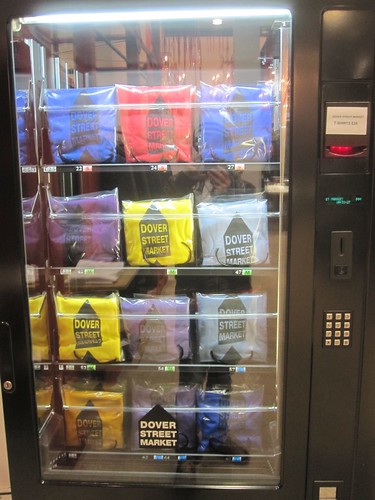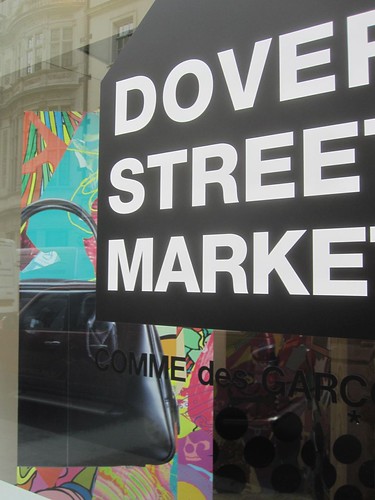dover street market "Comme des Garçons" vending machine @ dsm, london
Image by coolhunting "tapas"
Translated from French into English: “like boys”
Headquarters: Tokyo, Japan
The owner and founder of Comme des Garçons is Rei Kawakubo. This company, a private one, opened for business in the fashion industry in 1969. Since the opening of the company, there are now more than 12 boutiques and at least 200 merchants worldwide. One location considered high fashion in Tokyo (Aoyama) has flagship depots and one called “Place Vendome in Paris”, which is highly famous for its fashion line too. The business brings in annual revenue of approximately 0,000,000 (gross revenue). As of 2007, the business employed around 200 individuals.
Brief History of Commes des Garçons
Although Rei Kawakubo founded and opened the business in 1969, the company was not officially established until a few years later, in 1973. In Japan, the business became triumphant in the fashion industry in the mid-70s and added to their product line, for men, in 1978. In 1981, there was a show in the Paris location, which was a first appearance of Comme des Garçons and its leading fashion in “distressed” and “black” materials used in the clothing line. During the 1980s, this line of apparel frequently had a shattered appearance to it.
Once the debut in Paris completed, the company displayed pictures at some famous fashion locations in Paris. The pictures were the work of Peter Lindbergh. About 20 years later, another debut occurred in Tokyo. The debut consisted of marketing and illustrative sketches.
Comme des Garçons and its Fashion Line
The company uses a studio in Tokyo (Aoyama), where the fashion line is planned, but the rest of the products are finished in France, Japan, Turkey and Spain. The name of the studio where the company finishes making the clothing is the Comme des Garcons.
During the life of this company, they have created a few different collections. One collection earned the name “lumps and bumps” set. This apparel consisted of materials in vastness and little orbs on the articles of clothing, which looked like they had “lumps and bumps” on them. That was in 1997. This line of clothing created an association between the owner of the company and a choreographer from New York, Merce Cunningham, titled the “Scenario” assortment. This apparel was part of the spring and summer collected works.
Nine years later, in 2006, a new idea arose, which was “yssup”. The idea represented clothing and the various ways we introduce ourselves to the “sinep”. Blending customized masculine clothing with additional womanly constituents, for instance, floral patterns on the fabric, created “persona” and yet another assortment of fashion design that mixed female features into masculine garments. These collections were the fall and winter lines.
Commes des Garcons partners with many other famous brand name companies, like Levi Strauss, Converse footwear (All Star), Nike, Cutler and Gross, Lacoste, Speedo, Moncler, Hammerthor, Louis Vuitton, Chrome Hearts and numerous additional popular fashion businesses. The company joined forces with H&M and brought out a new line of clothing in the fall of 2008.
www.commedesgarcons.org
Dover Street Market
17-18 Dover Street
London W1S 4LT, UK
www.comme-des-garcons.com/
dover street market: Comme des Garçons
Image by coolhunting "tapas"
Translated from French into English: “like boys”
Headquarters: Tokyo, Japan
The owner and founder of Comme des Garçons is Rei Kawakubo. This company, a private one, opened for business in the fashion industry in 1969. Since the opening of the company, there are now more than 12 boutiques and at least 200 merchants worldwide. One location considered high fashion in Tokyo (Aoyama) has flagship depots and one called “Place Vendome in Paris”, which is highly famous for its fashion line too. The business brings in annual revenue of approximately 0,000,000 (gross revenue). As of 2007, the business employed around 200 individuals.
Brief History of Commes des Garçons
Although Rei Kawakubo founded and opened the business in 1969, the company was not officially established until a few years later, in 1973. In Japan, the business became triumphant in the fashion industry in the mid-70s and added to their product line, for men, in 1978. In 1981, there was a show in the Paris location, which was a first appearance of Comme des Garçons and its leading fashion in “distressed” and “black” materials used in the clothing line. During the 1980s, this line of apparel frequently had a shattered appearance to it.
Once the debut in Paris completed, the company displayed pictures at some famous fashion locations in Paris. The pictures were the work of Peter Lindbergh. About 20 years later, another debut occurred in Tokyo. The debut consisted of marketing and illustrative sketches.
Comme des Garçons and its Fashion Line
The company uses a studio in Tokyo (Aoyama), where the fashion line is planned, but the rest of the products are finished in France, Japan, Turkey and Spain. The name of the studio where the company finishes making the clothing is the Comme des Garcons.
During the life of this company, they have created a few different collections. One collection earned the name “lumps and bumps” set. This apparel consisted of materials in vastness and little orbs on the articles of clothing, which looked like they had “lumps and bumps” on them. That was in 1997. This line of clothing created an association between the owner of the company and a choreographer from New York, Merce Cunningham, titled the “Scenario” assortment. This apparel was part of the spring and summer collected works.
Nine years later, in 2006, a new idea arose, which was “yssup”. The idea represented clothing and the various ways we introduce ourselves to the “sinep”. Blending customized masculine clothing with additional womanly constituents, for instance, floral patterns on the fabric, created “persona” and yet another assortment of fashion design that mixed female features into masculine garments. These collections were the fall and winter lines.
Commes des Garcons partners with many other famous brand name companies, like Levi Strauss, Converse footwear (All Star), Nike, Cutler and Gross, Lacoste, Speedo, Moncler, Hammerthor, Louis Vuitton, Chrome Hearts and numerous additional popular fashion businesses. The company joined forces with H&M and brought out a new line of clothing in the fall of 2008.
www.commedesgarcons.org
Dover Street Market
17-18 Dover Street
London W1S 4LT, UK
www.comme-des-garcons.com/
World : Sense : Hospitality - The Mövenpick Amsterdam - The Netherlands - Design : Refine : Extraordinary! Function : Design = Enjoy!:)
Image by || UggBoy♥UggGirl || PHOTO || WORLD || TRAVEL ||
VIEW - FUNCTION : DESIGN - ON BLACK
Here another form of function:
Structural functionalism
Structural functionalism, (in some contexts simply Functionalism), is a broad perspective in sociology and anthropology which interprets society as a structure with interrelated parts. Functionalism addresses society as a whole in terms of the function of its constituent elements; namely norms, customs, traditions and institutions. A common analogy, popularized by Herbert Spencer, presents these parts of society as "organs" that work toward the proper functioning of the "body" as a whole.[1] The perspective was implicit in the thought of the original sociological positivist, Auguste Comte, who stressed the need for cohesion after the social malaise of the French Revolution. It was later presented in the work of Émile Durkheim, who developed a full theory of organic solidarity, again informed by positivism, or the quest for "social facts". Functionalism also has an anthropological basis in the work of theorists such as Marcel Mauss, Bronisław Malinowski and Radcliffe-Brown. It is in Radcliffe-Brown's specific usage that the prefix 'structural' emerged.[2]
Classical functionalist theories are defined by their tendency towards biological analogy and notions of social evolutionism:
Functionalist thought, from Comte onwards, has looked particularly towards biology as the science providing the closest and most compatible model for social science. Biology has been taken to provide a guide to conceptualizing the structure and the function of social systems and to analysing processes of evolution via mechanisms of adaptation ... functionalism strongly emphasises the pre-eminence of the social world over its individual parts (i.e. its constituent actors, human subjects).
– Anthony Giddens The Constitution of Society 1984
BY
WIKIPEDIA = FUNCTION = SOCIOLOGY = LIFE
Design
No generally-accepted definition of “design” exists, and the term has different connotations in different fields (see design disciplines below). Informally, “a design” (noun) refers to a plan for the construction of an object (as in architectural blueprints, circuit diagrams and sewing patterns) and “to design” (verb) refers to making this plan[2]. However, one can also design by directly constructing an object (as in pottery, cowboy coding and graphic design).
More formally, design has been defined as follows.
(noun) a specification of an object, manifested by an agent, intended to accomplish goals, in a particular environment, using a set of primitive components, satisfying a set of requirements, subject to constraints;
(verb, transitive) to create a design, in an environment (where the designer operates)
Here, a "specification" can be manifested as either a plan or a finished product and "primitives" are the elements from which the design object is composed.
With such a broad denotation, there is no universal language or unifying institution for designers of all disciplines. This allows for many differing philosophies and approaches toward the subject (see Philosophies and studies of design, below).
The person designing is called a designer, which is also a term used for people who work professionally in one of the various design areas, usually also specifying which area is being dealt with (such as a fashion designer, concept designer or web designer). A designer’s sequence of activities is called a design process. The scientific study of design is called design science.
Designing often necessitates considering the aesthetic, functional, economic and sociopolitical dimensions of both the design object and design process. It may involve considerable research, thought, modeling, interactive adjustment, and re-design. Meanwhile, diverse kinds of objects may be designed, including clothing, graphical user interfaces, skyscrapers, corporate identities, business processes and even methods of designing.
BY
WIKIPEDIA = DESIGN = OVERVIEW = MEANING
ON LOCATION: MOEVENPICK HOTEL AMSTERDAM, FLOOR 19, TABLE LAMP DESIGN, BACKGROUND, EXECUTIVE CLUB ROOM WITH LOUNGE ACCESS.
Design for Town and Village Plots at Stations on the Canadian Pacific Railway (1877)
Image by Manitoba Historical Maps
Fleming, Sandford. Design for Town and Village Plots at Stations on the Canadian Pacific Railway Referred to in Report on Surveys of the Canadian Pacific Railway, 1877, Pages 90 to 95 [map] Scale not given. In: Report on the Surveys and Preliminary Operations on the Canadian Pacific Railway up to January 1877. Ottawa: Sandford Fleming, 1877, Sheet No. 5.
Photo Lith. By Burland Desbarats Co. Montreal
Printed by MacLean, Roger & Co., Wellington Street Ottawa
A slight variation from the accepted gridiron town pattern was proposed for western Canada by Sandford Fleming, the Engineer-in-Chief of the CPR in 1877. In his plan the pattern would still be a gridiron, but oriented so that the corner of the grid pointed to the railroad, with a small plaza left right next to the track. Provision was made for a village and town common, and for farm lots behind the built-up area. The amazing thing about these town and village plans is that though they were proposed by a railroad engineer, they do not provide for a solid façade of businesses facing the line, in the fashion considered desirable by some railroad companies. Even though Fleming’s planes did not come to fruition, they at least show that some attempt was made at strategic village and town planning in the West, beyond the idea of simply superimposing the traditional railroad-oriented North American grid on the land.
(Warkentin and Ruggles. Historical Atlas of Manitoba. map 180, p. 368)
No comments:
Post a Comment